MotoCzysz Factory Tour
Portland, Oregon
"I was reading an article on the Motoczysz in MCN. I never read MCN but I was reading this article and they were slagging off this American builder’s bike. The more I read the article the more I started taking issue with them because they were slagging it off because they didn’t understand the intent of the design. I started defending the design to the article. A few weeks later I looked on the Motoczysz website and they didn’t have any job descriptions that matched mine so Adrian and I wrote up our own job descriptions, sent them in and applied for the jobs. A few months later we had left Cosworth and we were working here.” This is how Simon Jackson described his recent emigration from England to America and from Cosworth to MotoCzysz.
I remember having a similar reaction to the first article I read on the Motoczysz (this is pronounced Motosizz) project in the January 2005 issue of Roadracing World. At first I think I was personally offended that someone had the audacity to challenge the conventional wisdom that only Italians and Japanese can build racebikes. My irrational emotional reaction was that it was offensive for someone to propose building a MotoGP bike outside of the one of the five established manufactures much less by an American architect of whom I had never heard. Reading one long uninterrupted quotation after another I struck an uneasy balance between grudging respect for the design philosophy but could not quite let go of the resentment about some of the declarative statements.
As I read through it again I was still struck that many of the design ideas sounded brilliant. Counter rotating longitudinal crankshafts to improve handling, tuned flex forks to reduce chatter and provide consistent fork action, quick access transmission, a long swingarm with constant chain tension. It is all the types of advanced thinking that we reveled in when John Britten was making his own carbon wheels in his back shed. I loved reading about Ian Cramp’s ultimately abandoned attempt to build a 500GP bike in the mid-90s. So why did I have a twinge of resentment about an American attempting the same?
I finally came to the conclusion that Britten always came off at the very picture of modesty and humility and, in the interviews, Michael Czysz comes off as being a little cocky. His declarative statements made sounded like confidence tipping over the edge to hubris. And lastly, every genetic motorcycle aficionado has dallied with the idea of designing a bike. Some have even built a couple. But ultimately we tell ourselves that is it impossible to build a revolutionary race bike because if it could be done then Honda or Suzuki or Ducati would have already done it. And if Czysz pulls it off, it demonstrates not only that it can be done, but the reason that the rest of us didn’t do it was because we were not talented enough, diligent enough, hard-working enough or smart enough.
Czysz’s success, therefore, would highlight the failings of every dreamer. And so I, and thousands of others, read with respect but were touched by envy.
And, of course, there is the racer in all of us that thinks “You talk a mean game in the pits, but show me the lap times.” Statements of superior design seemed awfully hollow when they were not backed up by lap times. The initial round of publicity seemed premature.
But that was because I missed one of the points of that round of publicity. It served the interest of the project in two ways, it helped raise the profile of the company and the product to current and prospective investors, the second was that it raised a light around the world to like-minded engineers, designers and fabricators. They started sending in resumes from around the country as well as England, Austria and Italy. Motoczyzc grew from a crew of four to a crew of twenty-two with top people ranging from engine design to composites to patent law. They tripled their dedicated square footage and ordered up (my estimate) at least a million dollars worth of machine tools. They formed a formal corporation. Established a board of directors and began building relationships in the racing community as well as in the manufacturing community.
None of this would have been possible without some notoriety and publicity that would have been impossible without a round of interviews and firm, declarative statements. The publicity a year ago wasn’t about lap times, it was more a call for help from friends to come pull an all-nighter to get the race bike together. Only in this case it was a call to the global economy and the all-nighter is for two years. Lap times are still a little ways off.
The Man
Michael Czyzc. Born 05/29/1964, grew up in southern Oregon with some time in San Bernadino, studied at Parson’s in New York and Portland State University. He married Lisa in 1988 and has two sons Max (7) and Enzo (9). He started his architecture firm Architropolis (architropolis.com) in 1990. Through his work with Architropolis he earned a reputation for designing high-end successful residential and commercial properties including projects for such notables at Lenny Kravitz and Cindy Crawford. His commercial work includes resorts, hotels and casinos including, most recently, the Red Rocks resort in Las Vegas Nevada.
His first motorcycle was a 65cc Yamaha dirtbike that he got when he was eleven. He began roadracing a Aprilia 250 streetbike in 1994 with OMRRA when he was thirty years old. He switched up to an AF1 (a real 250cc GP bike) in 1996 and won the OMRRA regional championship. In 1999 he was able to get his hands on a full on factory RSV250cc just one step down from the world spec. At that point it was only his third year racing and he took this sensitive piece of equipment straight to the AMA. The AMA was a tough proving ground and (something with kids) was able to build his architecture firm while still (insert) racing accomplishments.
The racing interest is not that of a dilettante but of a fourth generation motorhead/designer/engineer. Michael’s earliest memories are all of being surrounded by motorcycle engines and frames. Friday nights were spent sleeping on the workbench in the back of grandfather’s van at Ascot. His family’s surname has been twisting tongues at racetracks for sixty years. This history includes some accomplishments at prestigious levels of racing. For instance Michael’s grandfather Clarence Czysz built a Norton engine to power a Cooper T17 to a world land speed record of 118.271 mph in 1955. In 1965, Terry Czysz (Michael’s dad) tuned a Norton which competed at the Daytona USGP and took second place to Mike “the bike” Hailwood on his factory MV Agusta.
This is not a man or a family that is unfamiliar with the Sisyphean task of racing. The know all about shattered connecting rods, broken valve springs, late nights, long drives, sacrifice and hard work. They are very familiar with competing with the limited resources against teams with far greater depth of talent. This family has been there and done that.
Most of the rogue race bike builders we’ve seen in the past were engineers. Czyzc is a designer. And a designer that spent some of his formative years in LA. Designers, by nature, must be very concerned with appearances. A designer not attuned to the emotional impact of appearance would have a very short career. As such, Michael brings a lot of style to everything he does. His office is a mix of minimalist clarity and 60s love nest. He is attuned to the way the workshops look, personally involved in the design of the apparel, opinionated on the wattage of the lights for displays and dresses more the part of LA casual that grease under the nails bike racer.
He is handsome, charismatic, friendly and clearly talented. He is patient and polite with his team, cool in the face of chaos, reasonable with the multitude of frustrations and late deliveries involved in a project but clearly passionate about motorcycles. The commercial building and the bike collection imply a great deal of debt or, more likely, decent (but not exorbitant) financial success earned through gift and hard work. Contrary to the stylized mogul photos and in contrast to the declarative quotations he is pretty down to earth.
The impression of him that I had from their website and other interviews was of a bit of a egotistical design guru of a sort that would be more typically found in the fashion or art world rather than the motorcycle industry.
With an expectation of meeting someone who is a little too sure of themselves, a little too smug in their own talents, a little too slick, I was pleasantly surprised to find that he is casual and engaging. He makes up words, uses the term “dampener” for “damper” and, when sitting on the lowered bike lift staring at the mock-up of a racebike peppers his language with expletives just like the rest of us. His very talented staff are respectful and clearly fond of him but are not obsequious.
He was somewhat taken by surprise at some of the negative reactions that his motorcycle project have garnered in magazines and, particularly, postings on the Internet. He isn’t even too fond of the name MotoCzysz that was originally a working title and ended up being adopted permanently. Many brands, of course, were proper names (Harley-Davidson, Honda, Michelin, Dunlop, etc etc) but Czysz has got an awful lot of consonants in it for the North American eye.
Lastly, in my estimation Michael Czysz would achieve greater financial success in his lifetime had he dedicated the energy expended on this company and bike towards client development for the architecture firm. The company will ultimately have to turn a profit to survive but for Czysz it is all about the bike.
The Firm
Architropolis is primarily known for its luxury no-compromise design and builds whose work has been widely reviewed by a myriad of national and international architecture periodicals. Architropolis is housed in a non-descript 1950 industrial building in Portland Oregon. A low slung two story building with high ceilings and big square warehouse windows. The west side of the building is dedicated to architecture, The east side of the building is dedicated to MotoCzysz. Michael’s office sits in the rear of the building with a door into either half.
The two businesses are incorporated separately. In the last two years MotoCzysz has been formally incorporated, raised additional capital by selling shares of the company to various private equity and venture capitalist, hired an additional eighteen people, tripled its occupied square footage, invested in production and testing machinery and almost formalized the goals and timeline for the company.
MotoCzysz is currently financed using the sale of equity (or shares in the Limited Liability Company or LLC) to investors. Czysz himself retains over 50% of the shares of the company and thus, typically, control.
The following are my baseless estimates. These numbers are my estimates. The published amount of money spent to date was $1.5 million on the design and prototyping as of June 2005. Since that time the staff and machinery has expanded tremendously. My estimate is that the burn rate at MotoCzysz is somewhere in the neighborhood of $250,000 a month depending on the amount of outside parts sourced in any given month. Staff costs alone must be in the $120,000 to $150,000 a month range before getting into lease payments on machine tools, rent, and purchasing of externally sourced parts like engine parts or frames. At this rate MotoCzysz is going to be running through around three to four million a year with not much expectation of positive revenue for at least five years. That is a pretty large financial hole.
When I bounced my calculations off of one of the visiting venture capitalist he smiled like he knew something I didn’t and spoke confidently of his faith that this investment will yield a good return over time.
MotoCzysz has recruited top talent from around the world. Cosworth alumi lead up the engine department, a composite specialist from Austria that not only designs the carbon fiber cut patterns for the frames but personally lays up the bodywork in the back. Ex-Ducati employees are sprinkled throughout the workforce and MotoCzysz has its own dedicated employee from Magnetti-Marelli to handle the immensely challenging problems of fuel injection, data logging, wiring harness, ignition and instrumentation. Despite being the largest growth engine in the American economy, much of the federal regulations governing business are weighted heavily in the favor of big business. MotoCzysz is running square into these dynamics which range from DOT and EPA regulations of motor vehicles to immigration restrictions which create costly and maddening delays in assembling staff, and thus, motorcycles.
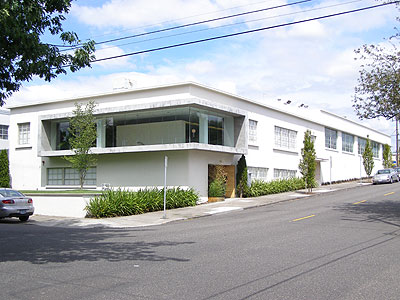
The Czysz headquarters which houses both
MotoCzysz and Architropolis in East Portland, Oregon.
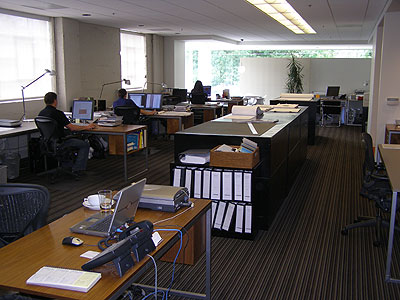
The architecture side of the Czysz operations.
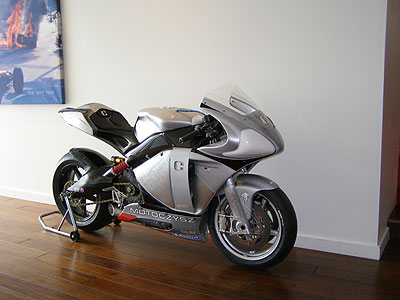
The 2005 C1 languishes in a corner of Michael’s expansive private office.
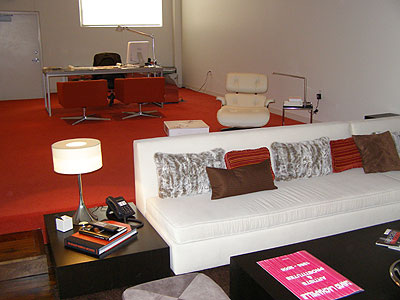
Michael’s expansive private office with doors into both MotoCzysz
and Architropolis.
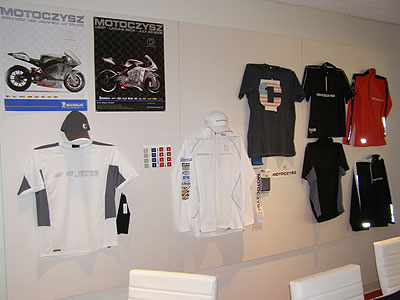
MotoGP 2005 / 2006 posters and apparel are laid out in the conference
room pending the final design decisions before production and loading
the truck. All of which will have to occur in the next week.
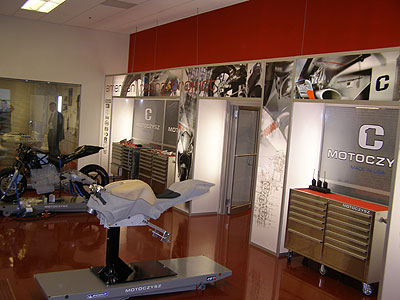
Part workshop, part showcase, part investor relations. The assembly room
for the new C1. In the foreground is a frame made of rapid prototype epoxy,
in the background is an actual chassis with a rapid prototype engine, behind
the glass in the far background is a meeting room with an actual angel investor.
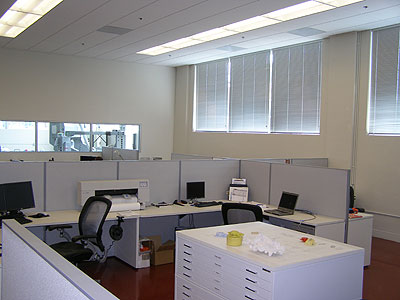
The bike design desks with seating for about fifteen. The room also contains
a lunch table but the architecture side has the better espresso maker, which
no doubt is an additional incentive for the motorcycle company to turn a profit.

One of the more unusual machines at the MotoCzysz plant is a computer
controlled mold making machine. It carves hard dense foam to a polished
finish to computer generated shapes to allow for rapid prototyping, and
finished production of composite pieces. Composite construction has its
own dedicated room of about 1,000 square feet.
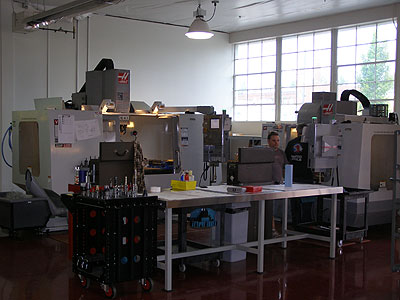
These are a portion of the machine tools at MotoCzysz. These are very
expensive machines which allow skilled operators to turn computer drawings
into finished parts relatively quickly. All of that said, building even just
a single part for a motorcycle is a time consuming chore.
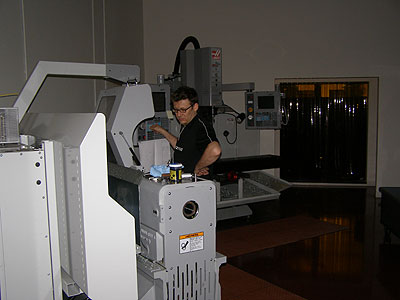
Small companies require that individuals wear a lot of hats and only loose
connections with their formal job descriptions. In a graphic representation
of this work ethic here the president of MotoCzysz, Federico Cioni,
turns parts at the lathe.
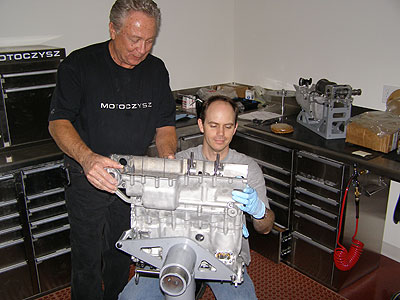
Terry Czysz and Simon Jackson work to build the very first MotoCzysz engine.
This is not like assembling a GSX-R motor because none of these parts have
ever been installed together in the past. That means that every single clearance
and tolerance and gasket and seal and bearing and torque spec and thread
pitch and assembly order and roll pin and alignment have to be checked,
and rechecked and disassembled and rechecked again.
The Plan
On the idea that history repeats itself, first as tragedy and second as farce, Czysz is, to some extent following in Buell’s footsteps. Eric Buell first bike was a square four two stroke that was designed to be raced in the AMA Formula 1 class. As his design came to fruition, the AMA adopted superbike rules that made the Buell ineligible and obsolete in one line of the rule book.
In this case the Czysz is facing a similar circumstance. The C1 (v2) is 990cc which is the displacement limit for MotoGP, until next year, when they get dropped (almost exactly as has happened in the past) to 800cc. The MotoGP targeted C1 will, therefore, be ineligible for competition in pretty much any class in the world except for WERA endurance and WERA Formula 1.
Aware of this rule based obsolescence MotoCzysz would really like to get their bike on the track in a MotoGP race this year and they are aiming for a wild card entry, potentially for Valencia. Since the bike is still being bolted together for the first time ever nary 100 feet from where I sit on July 10, 2006 they has a long way to go in terms of testing, tuning, refinement, and, probably worst of all, lobbying Dorna for a wildcard exception for a single round of competition. Witnessing the dedication, multi-tasking and steady progress, it still seems possible that they will do it.
Participation and, more importantly, qualifying for a MotoGP is incredibly difficult and would be a tremendous accomplishment for MotoCzysz as well as a very important step in laying the ground work for building a mystique and soul for the company.
Regardless of racetrack outings MotoCzysz is planning to being production of their first fifty motorcycles this fall. These fifty bikes will be sold for $100,000 each with deposits being accepted at the USGP of $10,000. These bike will not be street legal and they will only be eligible, in the US, for WERA Endurance or Formula 1. At that price, and restricted to track days or WERA racing these bikes seem mainly destined for collectors or wealthy enthusiasts more than general consumption. Assuming all the parts go together as planned and work as designed these bikes will be of an astounding level of performance.
Even at $100,000 each this first production run could easily result in a net loss of cash to MotoCzysz. Those familiar with the production costs associated with limited run no compromise fabrication will not be surprised by that revelation.
As the C1 will not be eligible for MotoGP in 2007 MotoCzysz has switched the target to racing in AMA Superbike. This will result in a massive increase in the cost of production to MotoCzysz. Not only will they have to build 150 to 300 units but those bikes will have to be street legal. Street legal means expensive DOT and EPA approval as well as engineering all that street equipment like lights, sidestand, mufflers, airfilters and the like. However, building a streetbike will also broaden the appeal of the brand to a much broader audience.
Depending on how the discussions go with the dynamic (meaning, perpetually in turmoil) AMA pro racing board MotoCzysz could be racing in the AMA as soon as 2007 but, more likely, in 2008. That is assuming the technology pans out, the investors keep writing checks and the rules are accommodating to the inclusion of a new brand.
Internally to the company the attitude towards racing is that, although expensive, it is imperative to both the development of a world-class performance motorcycle and of building the image around the brand; branding being paramount in the emotion driven motorcycle market. In other words qualifying for a MotoGP in 2006 would be well worth the expense for the world wide name recognition value alone. That is, as long as the bike does reasonably well and doesn’t fail catastrophically.
At this point there are not formal plans to build an 800cc engine to return the focus to MotoGP competition.
In addition to producing and selling complete motorcycles on a limited production basis, MotoCzysz will also be licensing some of its technology to other manufacturers.
The Bike
When I was visiting the production facility the parts where largely on the premises but where in the process of being converted into a running motorcycle with a deadline of having it at in eleven days. That said I was able to examine many of the pieces and look inside the engine but was unable to ride or otherwise experience the finished product. The plan is to test ride the bike at a race track in the last summer or early fall. At that time I will be able to give you the full technical write up because, quite honestly, just the engine alone has enough tasty details and expression of theory for an entire article alone.
One of the hardest aspects of the bike’s design was to get through my head that this is not a streetbike that has to withstand rain and dust. It is not a production bike with a retail price point of $12,000. It is not for any other purpose than to get around a racetrack very quickly. The designers barely cared about ease (ie cost) of engine production or ease of maintenance. It was not important that the frames cannot be straightened or that the valves are the absolute last thing to come out of the engine. This one is a no compromise track only bike. Keep that in mind.
Some of the tasty bits:
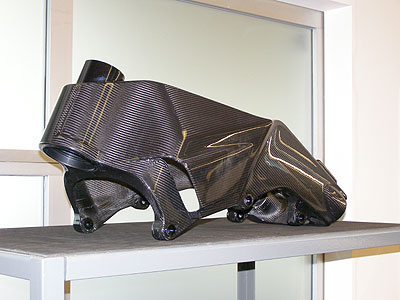
The frame is carbon fiber designed completely (including geometry and
even fabrication specifications) by MotoCzysz but fabricated in South Africa
where apparently there is a government subsidized composites industry.
This results in a light and incredibly stiff frame. Rigid frames tend to
overwhelm suspension systems at full lean angles as the tire is forced to
absorb all surface irregularities. In a conventional motorcycle the frame
flexes slightly laterally to absorb these bumps. The C1 does not.
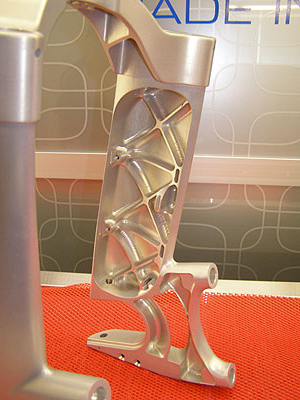
Instead of flex in the frame the C1 has suspension
components (forks and swingarm) that are designed to
be rigid in the suspension travel directions (up and down
and back and forth), but flex laterally to absorb bumps
from the side. This is done in the rear with a swing arm
that is extensively braced top to bottom but with a little
give side to side. The flex in the forks is provided in the
lowest portion of the fork leg. The large section front to
back resists deflection from braking but the thin section
side to side allows the fork to soak up bumps at lean.
At least that is the theory. The big oval in front of the
brake mount is for the axle insert.
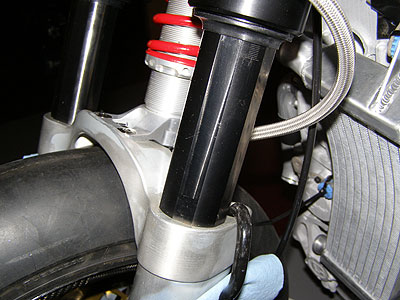
The fork tube is firmly attached to the lower oval sections of the fork like
in a conventional upside down fork. Telescopic forks slide up and down on
oiled bushings which, by necessity, have a bit of play in them. This play
introduces a bit of slop into the fork action. Also, when braking, the forks
can bind on those bushings. Really good forks, of course, have less slop and
less tendency to bind. These diamond like coated titanium fork tubes have
flat sections on them. The flat sections match linear roller bearings (imagine
a ladder where the ladder rungs are roller bearings) in the upper part of the fork.
These bearings positively orient the fork which makes it so it cannot bind no
matter what forces are applied to it. The damping and springing action of the
fork is contained by a single Ohlins unit mounted to the bridge of the sliders.
The arrangement eliminates variations between the tune on each fork leg and also
allows for the complete replacement of the valve stack and spring in a few minutes
through a simple external swap of damper units. Lastly, this damper is already gas
charged preventing cavitation of the damping oil. No leaking fork seals either.
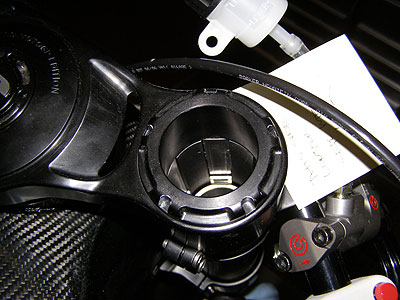
Peering down into the top of the fork one can see
the roller bearing down in there.
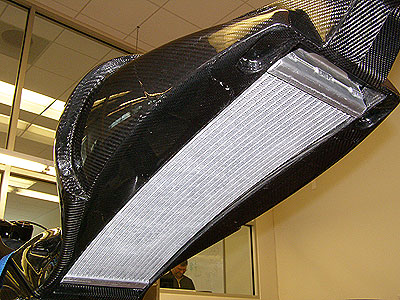
The bike has two tall skinny radiators up front. Air is also ducted from the
front of the fairing through the center of the bike to pressurize the top
area of the carbon fiber seat / subframe area. The high pressure air above
the radiator gets sucked through the radiator by the aerodynamic low
pressure zone created behind the bike. The theory here is that the frontal
area can be reduced with smaller radiators (and low frontal area typically
translates to a higher top speed for a given horsepower output) and high
pressure air can be routed to the back of the bike to help fill that low
pressure envelope in behind the bike. That in turn reduces the size of the
aerodynamic parachute that all race bikes tow around behind them
(see “higher topspeed for given bhp”) and would reduce the ability
of a following bike to draft this one.
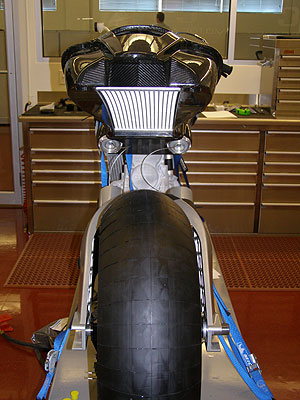
The pipes are not bolted on and there is no fairing but notice
that the rear wheel is wider than the engine. This bike is
incredibly narrow. It is crazy narrow. It is so narrow that it feels
like a dirt bike, not a 1000cc race bike. Keeping in mind that
horsepower requirements rise exponentially with speed so this
slender profile may make up for any deficit of horsepower.
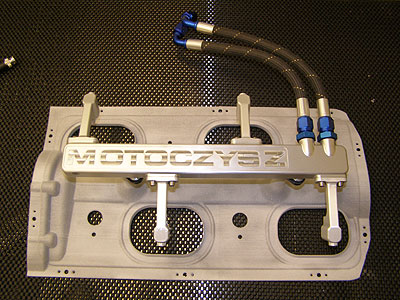
In the modern age there are two battles for racing success, hardware and
software. Most of the software comes into the engine management system
that incorporates the fuel injection and ignition systems. Of course now
those systems are integrated to the fly-by-wire throttle bodies (Czysz uses
manual control on two cylinders and computer control on the other two)
the all important data acquisition system and the dashboard display. These
systems can also incorporate electronically modified clutch action, launch
control and traction control. To solve virtually all of these problems in one
fell swoop Czysz teamed up with Magnetti Marelli which is the firm providing
many of the top GP and Superbike systems with their electronic and software
solutions. This is just a picture of the fuel rail with the shower injectors in place.
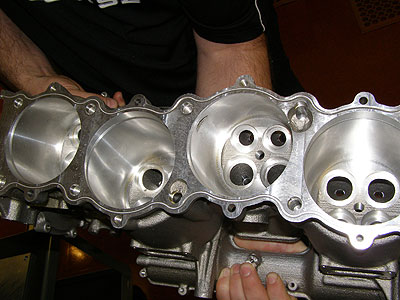
Michael knew what he wanted out of a motor, Adrian Hawkins and Simon
Jackson emigrated to the new world from Cosworth to make sure it all worked.
In short, Simon is in charge of anything that goes up and down or around
and around, Simon is in charge of making sure it all fits and that it is possible to
fabricate. Given the packaging, layout, and performance requirements of the
project Adrian had to come up with some pretty creative solutions. In order
to get the nested narrow V cylinders without giving away performance Adrian
had to design a block that contained both the cylinders and the valve head.
For those of you who do not know what a complete pain in the ass that would
be, it is an enormous pain in the ass. On the plus side there is no head gasket
and the combustion chamber should be extremely stout with a minimum about
of upper cylinder flex (upper cylinders often flex in high load situations),
on the downside the valves are the last thing out of the engine on a freshen
up and machining is more complicated. The blocks are cast in the U.S.
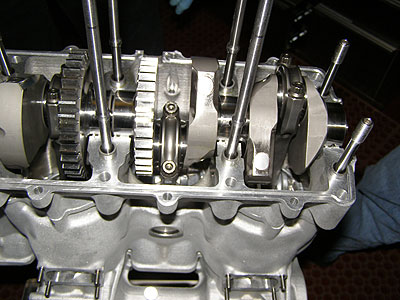
Some of Simon’s work. The cranks are counter rotating to cancel the inherent
gyroscopic effect on handling and you can see the split between the two
halves. The drive gear on the right crank is smaller than the left as its power
has to feed through an intermediate shaft to reverse its direction before both
cranks feed into a torque shaft which then goes through a clutch to the
transmission. The cranks are fabricated by Cosworth in England while the
rods are sourced from Saenz in Argentina. There are so many neat bits in this
motor that are not found in your average production engine. The rod journals
are heavily radiused for strength and there is a massive gap between the rod
and the crank webs. This gap ensures that there is no frictional loss between
the rod and the crank and the rod is positioned on the crank by having an
extremely strong and tightly toleranced piston. The crank’s oil passages are not
simply sealed with peened over ball bearings but are instead capped with little
allen bolts. This is not just so that the crank can be easily disassembled and
cleaned but also so that a machine tool can get into the connecting rod
journal of the crank to lighten it internally.
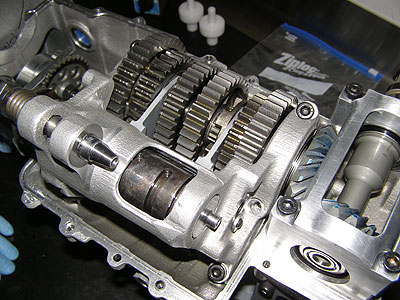
The transmission mounts below the crank so the entire engine is sort of
stacked up on top of itself. Transmission gears are very difficult to build
or source so the prototype here is fitted with GSX-R 1000 gears. In recent
years Suzuki has drifted far from its “great transmission” past but some
of those shortcomings are address in the Czysz with beautifully made
shift forks and shift drum. In the right of the photo you can see the
worm gears which shift the direction of power from the crank rotation
to the rear wheel rotation. In the distant left corner you can get a fuzzy
view of an oil pump and oil level sight window. The whole transmission
can be unbolted and dropped straight out of the bottom of the bike for
revisions to internal gear ratios or, if they retain the Suzuki bits, replacing
the 3-4 gear cluster at regular intervals.
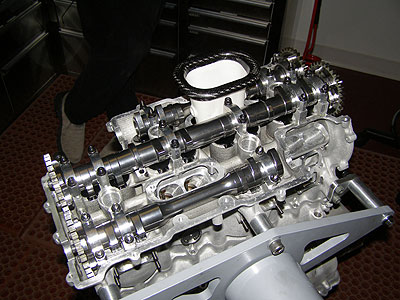
The three cams are gear driven to keep the cam timing as constant as
possible up to 16,000 RPM. The two outer cams are exhaust cams, the
center cam is the intake cam. These cams have a huge base circle to
allow for copious amounts of both lift and duration. The exhaust
cams are waisted in the center to allow clearance for the intake ports.
One velocity stack is fitted in back. The combustion chambers and
ports are all cut by computer. The cams are fabricated by Cosworth,
the titanium valves are sourced in the US and the valve buckets come
from France. The cam journals are pressure fed through the block
not internally lubricated from the cam as is common practice.
The shiny finish on the cams reduce friction and heat.
